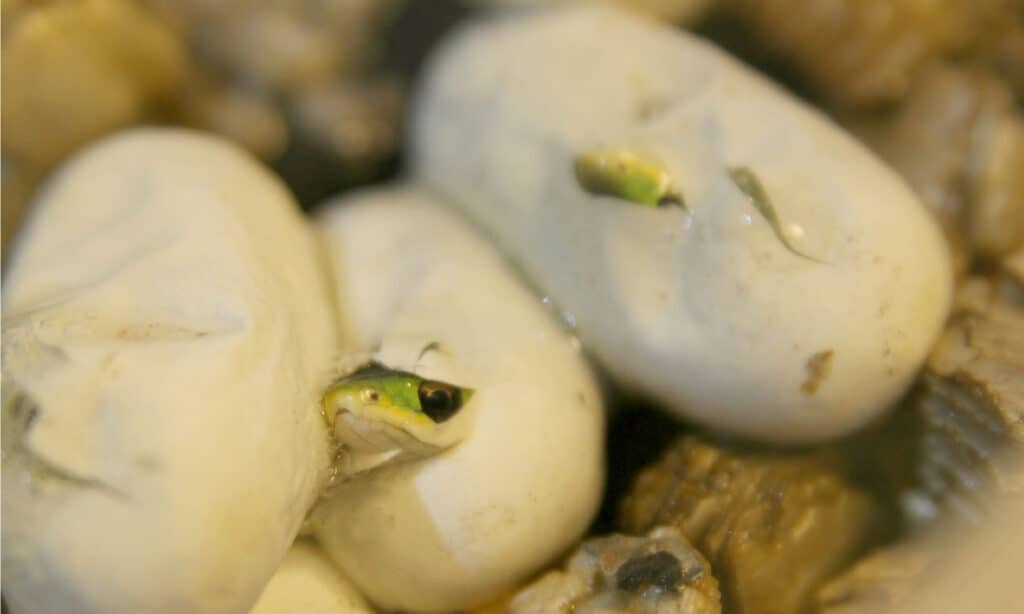
The post 7 Snakes That Give Birth to Live Young (As Opposed to Eggs) appeared first on A-Z Animals.
Many of us know snakes are ectothermic reptiles that regulate their body temperature behaviorally by using shade, burrows, warm rocks, and even metabolic heat from digestion. But not everyone is aware that certain species of snakes give live birth. But why do some snakes lay eggs, and others give birth to live snakelets (baby snakes)? Here, we’ll explore the different ways snakes reproduce, then take a closer look at seven species of snake known for giving birth to live young.
This post was updated on September 12, 2025 to clarify thermoregulation, ovoviviparity vs viviparity reproduction, sea snake range, power of garter snake venom, and Titanoboa size.
Wait, Don’t Snakes Lay Eggs?

Green snakes lay clutches ranging in size from 3-30 eggs.
©Stuart Hamilton/Shutterstock.com
There are three basic ways to make baby snakes. The first is called oviparous reproduction. In oviparous reproduction, male snakes fertilize the eggs inside female snakes. These eggs then develop inside the female until they’re reasonably sized and have the leathery shells you expect from snakes. She then lays the eggs, usually in a nest or an abandoned burrow. Depending on the species, she will either leave them or guard them and keep them warm until the snakelets hatch.
The second form of snake reproduction is viviparous, in which the mother gives birth to live young that develop entirely inside the mother, nourished by a placenta. Boas and anacondas fall into this category.
The majority of snakes that give live birth do so via the third means called ovoviviparous. It is somewhat of a combination of the above two. Males fertilize eggs, which then develop inside the female. The female incubates them internally, with each of the babies surrounded by a thin membrane and having its own yolk. The mother provides some, but not all, nourishment until the young are born.
What Kind of Snakes Give Live Birth?
Among them are most vipers, boas, anacondas, most water snakes and all sea snakes except for a single genus.
Let’s take a closer look at seven snakes that give live birth.
1. Death Adder (Acanthophis antarcticus)
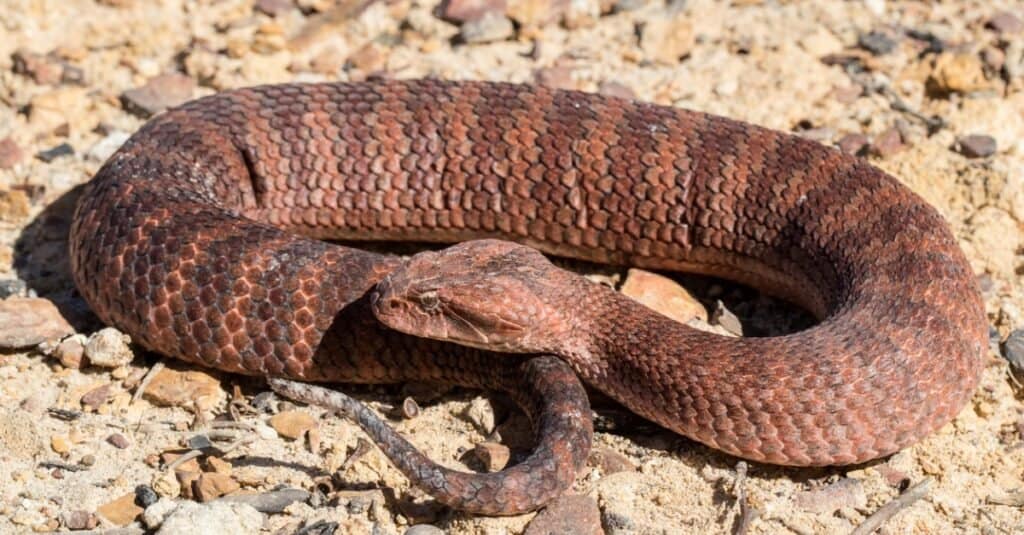
Death adders have wide, flat heads and vertical, elliptical pupils.
©iStock.com/Ken Griffiths
These snakes live in the Australian states of South Australia, Victoria, New South Wales, and Queensland. Death adders reside in both the coastal areas and inland areas of southern and eastern Australia but also live in Papua New Guinea. They’re highly venomous yet non-aggressive. They have among the longest fangs relative to body size of any snake in Australia.
Death adders are ovoviviparous and can birth up to 30 snakelets per birth. Their primary threats are habitat loss and population loss due to the invasive cane toad.
2. Western Diamondback Rattlesnake (Crotalus atrox)
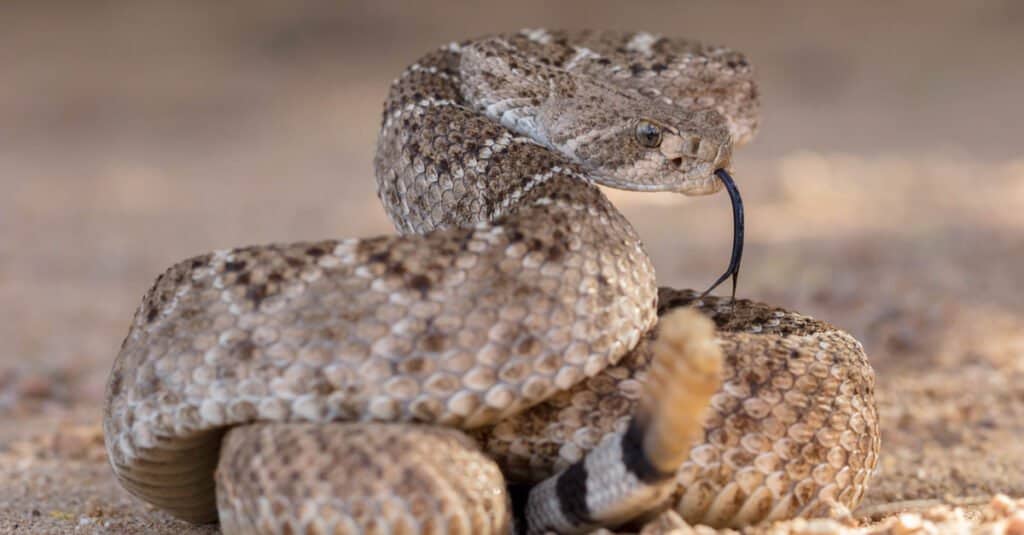
The western diamondback rattlesnake has special heat-sensing pits to find prey in the dark.
©Alexander Wong/Shutterstock.com
One of the largest rattlesnakes in the world, the western diamondback lives throughout the desert southwest regions of the United States and Mexico. It is highly recognizable both by the brown and tan diamond markings along its backs and noisy rattles.
Western diamondbacks typically carry their young for between 4-5 months before giving birth to 10-20 live snakelets. Baby western diamondbacks begin hunting after they absorb the remainder of their yolk and after their first shed, usually in about 9-11 days.
3. Green Anaconda (Eunectes murinus)
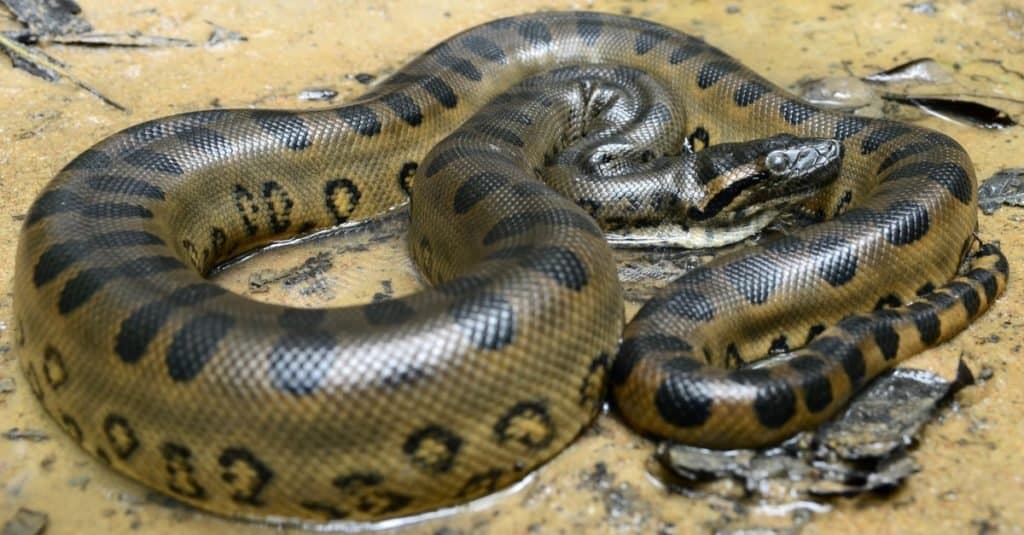
Baby green anacondas are nearly two feet long at birth.
©Patrick K. Campbell/Shutterstock.com
The green anaconda is one of the biggest snakes in the world. Green anacondas can grow to nearly 20 feet long and can weigh well over 150 pounds. Verified individuals exceed 200–250 pounds. Despite their huge size, they’re not venomous, relying instead on constricting their prey to death. They just might be one of the largest snakes that give live birth.
Luckily for anyone afraid of big snakes, green anacondas only live in South America. They’re semi-aquatic and spend most of their lives in the tepid waters of rivers, swamps, and wetlands.
4. Eastern Garter Snake (Thamnophis sirtalis sirtalis)
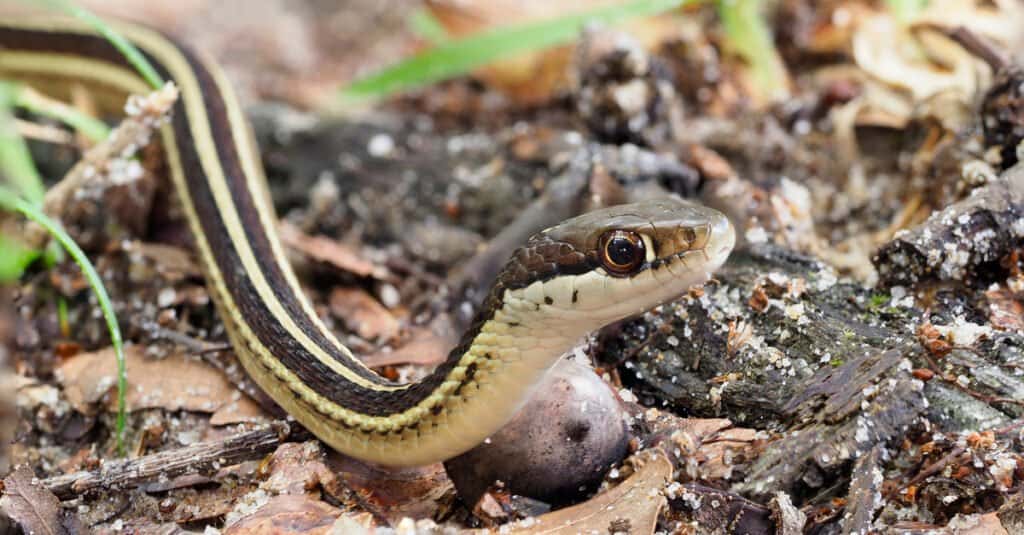
The garter snake is small and harmless to humans.
©Steve Bower/Shutterstock.com
Garter snakes are one of the most common snakes in North America. They produce mild venom via their Duvernoy’s glands, but it is not clinically dangerous to humans. Most have brown, yellow, or pale green sides and backs, with yellow stripes running from head to tail.
Like most snakes that give live birth, garter snakes leave their mother soon after birth. Snakelets are typically around six inches long and grow to about two feet long as adults.
5. Eyelash Viper (Bothriechis schlegelii)
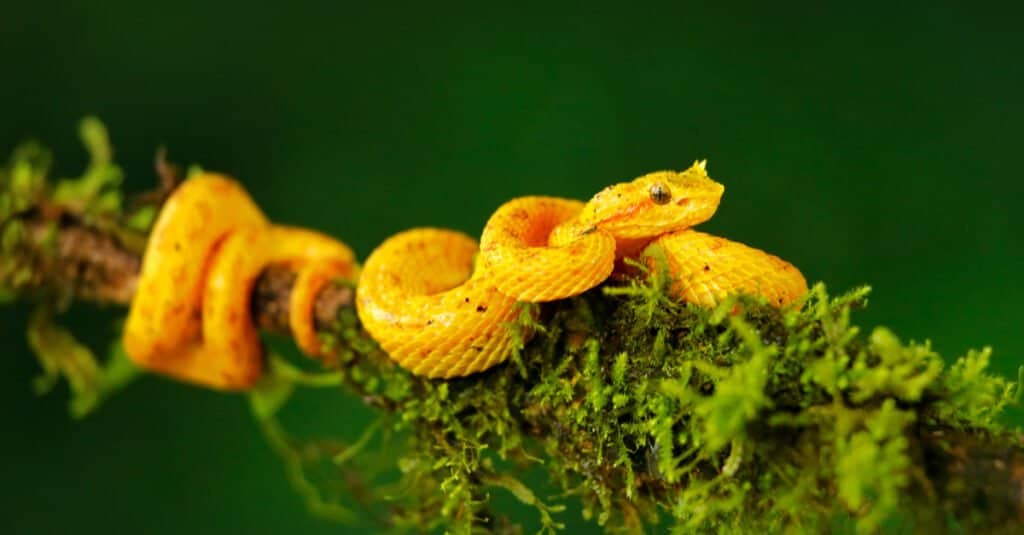
This pit viper is small and beautiful but venomous.
©Ondrej Prosicky/Shutterstock.com
One of the prettier species of viper, the eyelash viper lives in South and Central America. It is a highly venomous member of the pit viper family characterized by a set of scales above the eyes, resembling eyelashes.
These slender snakes come in an endless number of colors and patterns, including gray, yellow, tan, red, green, and brown. with snakelets measuring between 7-8 inches in length. Like most vipers, they eat mostly small birds and amphibians.
6. Yellow-Bellied Sea Snake (Hydrophis platurus)
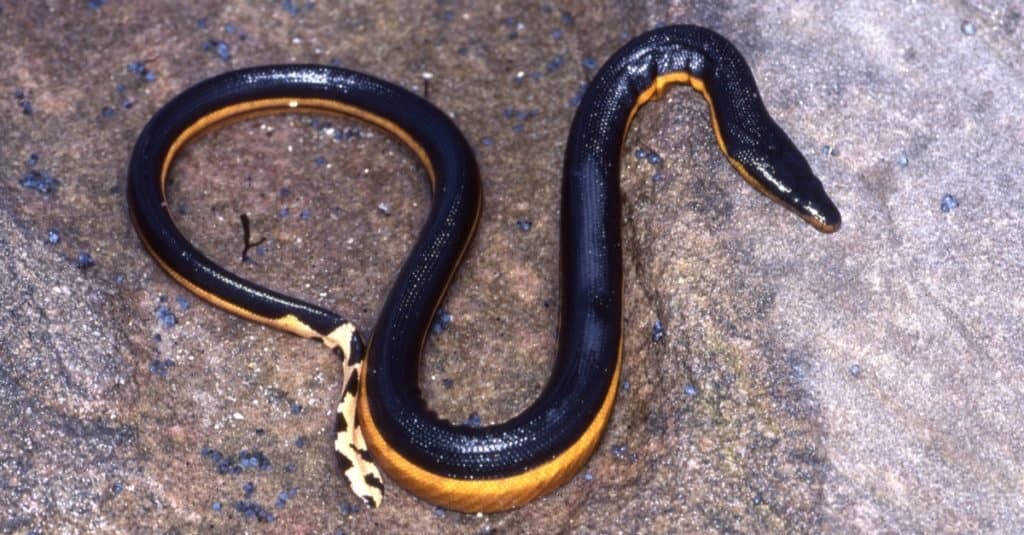
Yellow-bellied sea snakes give birth to live snakelets at sea.
©Ken Griffiths/Shutterstock.com
Yes, all snakes can swim. There are snakes, like the yellow-bellied sea snake, that spend most of their lives in the water. Though these snakes drift into the eastern Atlantic via currents, their main range is the Indo-Pacific and eastern Pacific. Like all sea snakes, these snakes give birth to live young. Females carry the snakelets for about six months before heading to shallow tidal pools to give birth.
Yellow-bellied sea snakes are two-toned, with black backs and yellow bellies. They have flattened tails that help them swim, as well as potent venom used to incapacitate fish. They don’t grow very big, with the biggest females reaching around three feet, but their bite certainly packs a punch.
7. Common Boa Constrictor
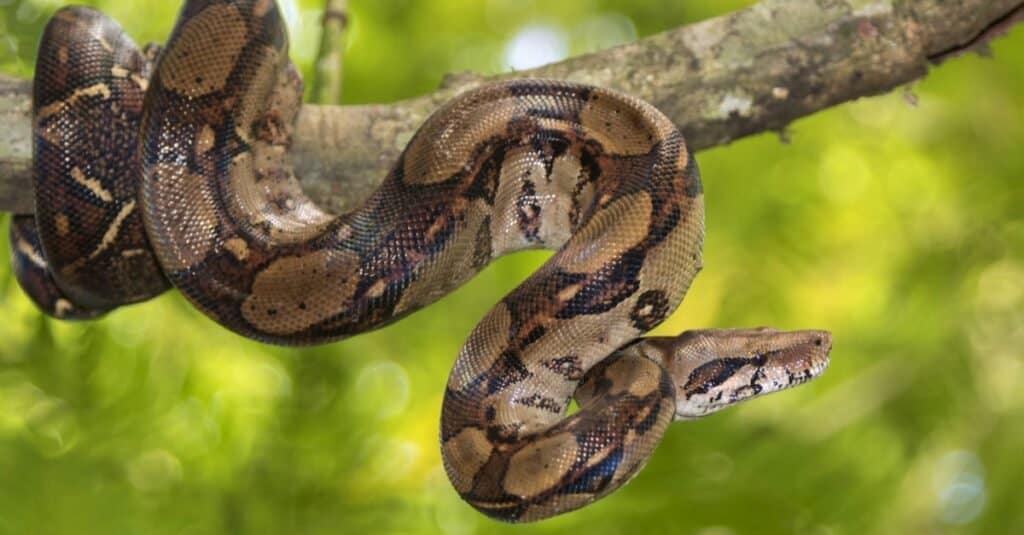
Boa constrictors give birth to up to 60 snakelets at a time.
©Natalia Kuzmina/Shutterstock.com
Native to the lush tropical forests of South America, the boa constrictor is one of the largest snakes in the world. It can grow to nearly 13 feet long and weigh up to 100 pounds. Moreover, it is a popular pet in the world and can grow to enormous proportions in captivity.
Female boas gestate their young for about four months before giving birth to around 30 snakelets. Out of all the snakes that give live birth, the boa has some of the biggest babies. At birth, boa constrictors are 15–20 inches long.
Other Reptiles That Give Birth to Live Young
In addition to snakes, other reptiles that give birth to live young include many species of lizards. Skinks are an example of a reptile that can lay eggs or bear offspring alive. Certain types of geckos also reproduce this way as well.
The reproductive process in slow worms is even more remarkable than in other reptiles that give birth to live young. Slow worms, which are technically lizards, lay eggs that hatch within their body, and then the offspring emerge from the mother’s cloaca. This is a unique form of reproduction for reptiles, and it has been studied extensively by biologists. It’s an interesting evolutionary adaptation as it allows slow worms to inhabit different climates without having to worry about incubating or caring for their young after they have hatched from eggs.
What is the Largest Snake Ever Found?
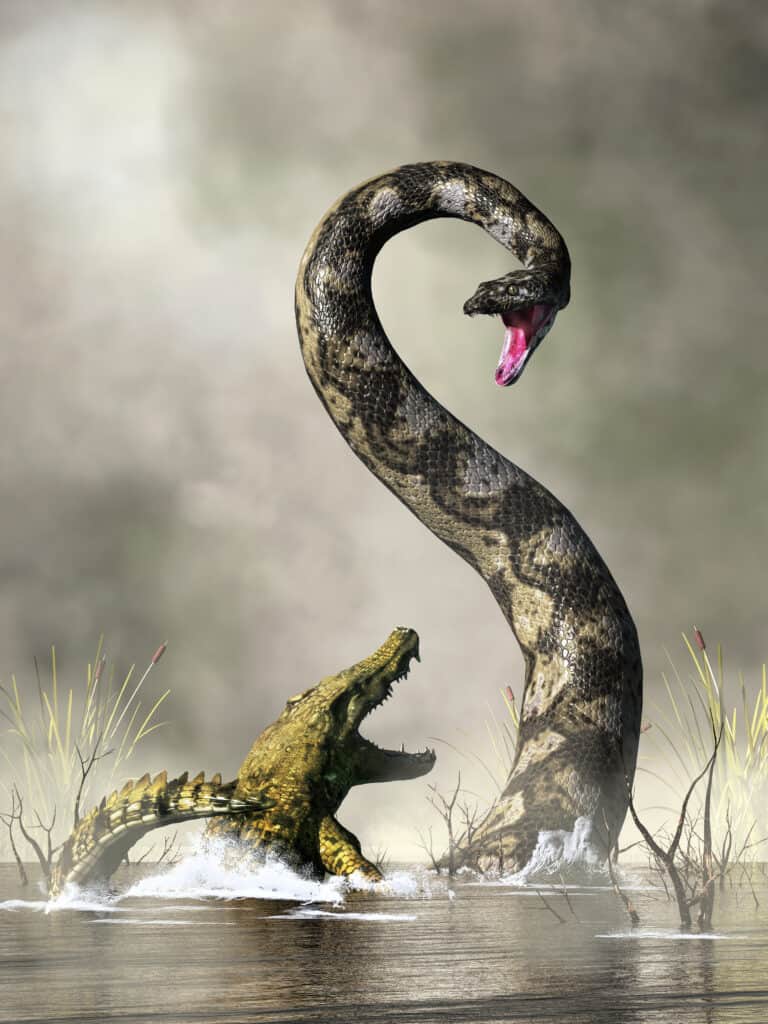
The Titanoboa is the largest snake to ever exist.
©Daniel Eskridge/Shutterstock.com
Like something directly out of a horror film or from one of the colossal Godzilla fights, the extinct and aptly named Titanoboa is the absolute largest snake in which scientists have ever found remains. It is estimated that this massive beast could perhaps reach an amazing length of 46 feet. It is also believed to have weighed around 1,600 pounds but could have weighed up to 2,500 pounds! For comparison, the heaviest anaconda on record weighed around 880 pounds.
The Titanoboa has been categorized into the Boidae family, which also holds anacondas and other boas. These snakes all have many similarities, but the size is what really sets the “titan boa” apart! The full scientific name is Titanoboa cerrejonensis, with the latter word being taken from the La Guajira mines in Colombia, South America.
Summary of the 7 Snakes That Give Live Birth (As Opposed to Eggs)

| Index | Species | Average Length |
|---|---|---|
| 1 | Death Adder (Acanthophis antarcticus) | 31 – 36 in |
| 2 | Western Diamondback Rattlesnake (Crotalus atrox) | 4 – 6 ft |
| 3 | Green Anaconda (Eunectes murinus) | 20 ft (female) |
| 4 | Eastern Garter Snake (Thamnophis sirtalis sirtalis) | 18 – 26 in |
| 5 | Eyelash Viper (Bothriechis schlegelii) | 22 – 32 in |
| 6 | Yellow-bellied Sea Snake (Hydrophis platurus) | 3 ft |
| 7 | Common Boa Constrictor | 6.9 – 9.8 ft (female) |
The post 7 Snakes That Give Birth to Live Young (As Opposed to Eggs) appeared first on A-Z Animals.
September 12, 2025 at 07:02PMBrandi Allred
.jpeg)
.jpeg)

0 Comments